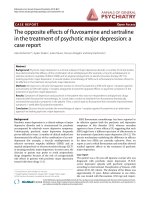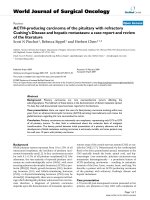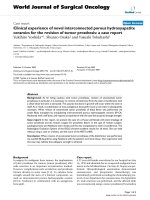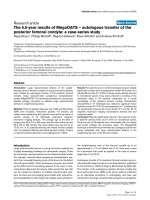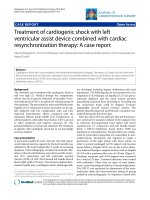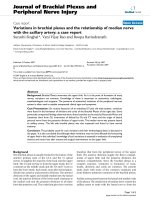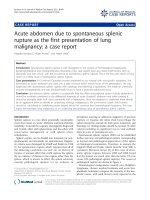Báo cáo y học: "Giant liver hemangioma resected by trisectorectomy after efficient volume reduction by transcatheter arterial embolization: a case report" ppt
Bạn đang xem bản rút gọn của tài liệu. Xem và tải ngay bản đầy đủ của tài liệu tại đây (1.72 MB, 5 trang )
CAS E REP O R T Open Access
Giant liver hemangioma resected by
trisectorectomy after efficient volume reduction
by transcatheter arterial embolization: a case
report
Nobuhisa Akamatsu
1,2
, Yasuhiko Sugawara
2*
, Masahiko Komagome
1
, Takashi Ishida
1
, Nobuhiro Shin
1
, Narihiro Cho
1
,
Fumiaki Ozawa
1
, Daijo Hashimoto
1
Abstract
Introduction: Liver hemangiomas are the most common benign liver tumors, usually small in size and requiring
no treatment. Giant hemangiomas complicated with consumptive coagulo pathy (Kasabach-Merritt syndrome) or
causing severe incapacitating symptoms, however, are generally considered an absolute indication for surgical
resection. Here, we present the case of a giant hemangioma, which was, to the best of our knowledge, one of the
largest ever reported.
Case presentation: A 38-year-old Asian man was referred to our hospital with complaints of severe abdominal
distension and pancytopenia. Examinations at the first visit revealed a right liver hemangioma occupying the
abdominal cavity, protruding into the right diaphragm up to the right thoracic cavity and extending down to the
pelvic cavity, with a maximum diameter of 43 cm, complicated with “asymptomatic ” Kasabach-Merritt syndrome.
Based on the tumor size and the anatomic relationship between the tumor and hepatic vena cava, primary
resection seemed difficult and dangerous, leading us to first perform transcatheter arterial embolization to reduce
the tumor volume and to ensure the safety of future resection. The tumor volume was significantly decreased by
two successive transcatheter arterial embolizations, and a conventional right trisectorectomy was then performed
without difficulty to resect the tumor.
Conclusions: To date, there have been several reports of aggressive surgical treatments, including extra-corporeal
hepatic resection and liver transplantation, for huge hemangiomas like the present case, but because of its benign
nature, every effort should be made to avoid life-threatening surgical stress for patients. Our experience
demonstrates that a pre-operative arterial embolization may effectively enable the resection of large hemangiomas.
Introduction
Liver hemangiomas are the most common benign liver
tumors, with a prevalence of 5 to 20%. Most hemangio-
mas are small and require no treatment or only follow-
up. However, giant hemangiomas, having a diameter of
more than 4 cm or 5 cm, may give rise to mechanical
complaints or coagulopathy requiring intervention [1].
The indication for treatment of giant liver hemangiomas
remains a matter of debate; hemangiomas c omplicated
with a consumptive coagulopathy (Kasabach-Merritt
syndrome) or causing severe incapacitating symptoms
are gen erall y accepted as an absolute indi cation for sur-
gical resection [2,3]. Once treatment is decided on , sur-
gical excision is the most e ffective method with a low
risk of morbidity and mortality [4,5], but other treat-
men t options, including transcatheter arterial emboliza-
tion (TAE) [6], and liver transplantation [7,8], are also
sometimes advocated for large unresectable hemangio-
mas. Except for liver transplantation, however, pa lliative
treatments usually do not produce satisfactory and sus-
tained outcomes.
* Correspondence:
2
Artificial Organ and Transplantation Division, Department of Surgery,
Graduate School of Medicine, University of Tokyo, 7-3-1 Hongo, Bunkyo-ku,
Tokyo 113-8655, Japan
Full list of author information is available at the end of the article
Akamatsu et al. Journal of Medical Case Reports 2010, 4:283
/>JOURNAL OF MEDICAL
CASE REPORTS
© 2010 Akamatsu et al; licensee BioMed Central Ltd. This is an Open Access article distributed under the terms of the Creative
Commons Attribution Lice nse ( which permits unrestricted use, distribution, and
reproduction in any medium, provided the original work is pro perly cited.
Here, we report a case of a single huge hemangioma,
completely res ected by a right trisectorectomy following
two successive TAEs, b y which the volume of the
hemangioma was significantly reduced.
Case presentation
A 38-year-old Asian man w as referred to our hospital
with complaints of severe abdominal distension and
pancytopenia. His past or family medical history was
unremarkable. Although his abdominal bloating was
impairing his daily life, he had not visited a healthcare
facility or undergone treatment for abdominal
distension.
A routine blood c ount revealed pancytopenia, with a
white blood cell count of 2600/μL, a red blood cell
count of 3.42 × 10
6
/μL, a hemoglobin level of 10.3 g/dL,
and a platelet count o f 9.2 × 10
4
/μL. The results of liver
function tests were normal, including a total bilirubin
level of 1.3 mg/dL, an albumin level of 4.3 mg/dL, and
an indocyanine green retention rate at 15 min of 8.7%.
“Asymptomatic” Kasabach-Merritt syndrom e was appar-
ent, however, based on a high international normalized
ratio o f prothrombin time of 1.46, a decreased fibrino-
gen level of 82 mg/dL, el evated fib rin degradation pro-
ducts (FDP) of 80 μg/mL, and D-dimer levels of 32 μg/
mL.
Multi-detector computed tomography (MDCT) on
admission revealed a huge hemangioma located on the
right liver, and replacing the parenchyma of the right
liver an d the lef t para-median sector. The hemangioma
occupied almost the entire abdominal cavity, protr uding
into the right diaphragm up to t he right thoracic cavity
and extending down to the pelvic cavity, with a maxi-
mum diameter of 43 cm (Figure 1). Angiography and
portography [reconstructed by MDCT images (Figure
2)] revealed that the right hepatic artery and its
branches were extremely stretched, and the right portal
vein was compressed and occluded by the tumor. The
middle and right hepatic veins were completely
occluded, and the hepatic vena cava was markedly com-
pressed, while the left hepati c vein remained patent
(Figure 3A-C). Volumetric analysis revealed a tumor
volume of 16,88 0 mL and a left lateral sec tor volume of
1250 mL.
Based o n the l iver function tests, remnant liver
volume, and anatomic considerations, urgent primary
tumor resection seemed possible, but because of the
benign nature of the disease and our patient’ sstable
condition, we decided to perform TAE to reduce the
tumor volume before performing the resection to ensure
the safety of the future radical resection of the tumor.
First, TAE was performed for the right hepatic artery
with coils and gelfoam. Thereafter, the tumor volume,
anatomical positions, and recanalizations were calculated
and investigated by dynamic MDCT once a month, not
to misjudge the operation timing. Three months after
the first TAE, the tumor volume had decreased to
10,290mL.Angiographyperformedatthattime
revealed a collateral feeding artery from the right sub-
phrenic artery, which was then embolized by TAE. Two
months after the second TAE, the tumor volume had
furth er decreased to 8260 mL based o n MDCT volume-
try (Figure 3A’-C’). No complication was observed after
two successive TAEs.
Figure 1 Coronal and sagittal views of the hemangioma. Reconstructed from multi-detector computed tomography images.
Akamatsu et al. Journal of Medical Case Reports 2010, 4:283
/>Page 2 of 5
The remarkable volume reduction in the right upper
portion of the tumor allowed for a safe approach to the
hepatic veins and vena cava, and a radical resection of
the tumor was performed by an anatomical right trisec-
torectomy. The operation was performed through a
J-shaped skin incision using a ninth inter-costal thora-
coabdominal appr oach (Figure 4), and after the conven -
tional right liver mobilization, the tumor was
successfully resected by anatomical division of the hepa-
tic hilum preserv ing biliary continuity with the
Figure 2 Vascular reconstruction images. (A) Angiography images reconstructed by multi-detector computed tomography (MDCT). The right
hepatic artery (white arrowheads) and its branches are markedly stretched. (B) Portography images reconstructed by MDCT. The right portal vein
is occluded (black arrowhead).
Figure 3 Axial images of multi-detector computed tomography. Multi-detector computed tomography (MDCT) images at the first visit (A-C),
and corresponding MDCT slices just before the operation (i.e. after two sessions of transcatheter arterial embolization) (A’-C’). Metallic coils in the
right hepatic artery (black arrowhead) and in the right sub-phrenic artery (black arrow) are indicated. LHV, left hepatic vein; UP, umbilical portion.
Akamatsu et al. Journal of Medical Case Reports 2010, 4:283
/>Page 3 of 5
intermittent inflow occ lusion. The operat ing time and
the intra-operative blood loss were 540 min and 2150
mL, respectively.
Pathologic investigation of the specimen reveal ed a
cavernous hemangioma, 30 × 25 × 15 cm, weighing
8100g,comprisingaspongyzoneandafibroticscar
zone with massive necrosis. Our patient’s post-operative
course was uneventful and he was discharged from the
hospital 16 days after surgery. At 24 months following
surgery, he enjoys an improved quality of life with nor-
mal liver function.
Changes in the laboratory data and tumor volume are
summarized in Figure 5. Despite the blood counts
becoming normal after TAE, fibrin degradation products
(FDP) and D- dimer decreased after the surgical removal
of the tumor.
Discussion
Of the various treatment options for giant hemangiomas,
surgical treatment, including resection and enucleation,
provides the only consistently effective outcome with
satisfactory results [4,5]. Although some authors reported
that symptomatic giant liver hemangiomas can be mana-
ged successfully an d non-invasively by TAE with a satis-
factory decrea se in symptoms and tumor volume [6], the
effect of TAE generally seems to be variable and some-
times even results in a volume increase [7,8].
A recent major argument in the treatment of liver
hemangiomas is the selection criteria for surgery; i.e.
observation or operation, and enucleation or resection.
Considering the benign and non-progressive nature of
the disease, it is currently accepted that a giant heman-
gioma is not necessarily an indication for surgery just
because of its size, and continued observation in
asymptomatic patients or patients with minimal
abdominal symptoms seems to be justified [2,3].
Because of variations in size, location, and number of
tumors, the surgical strategy should be decided on a
case-by-case basis. There s eems to be general agree-
ment that enucleation is better than resection in terms
of sparing the liver parenchyma a nd decreasing intra-
operative blood loss [4,5]. Large hemangiomas with
severe incapacitating symptoms, such as in our case, or
with symptomatic Kasabach-Merritt syndrome,
Figure 4 Intra-operat ive photograph of the tumor. Black arrow
indicates the cranial side.
Figure 5 Changes in t he labora tory data and tumor volume.WBC,whitebloodcell;Hb,hemoglobin;Plt,platelet;DD,D-dimer;Fib,
fibrinogen; FDP, fibrin degradation products; TAE, transcatheter arterial embolization.
Akamatsu et al. Journal of Medical Case Reports 2010, 4:283
/>Page 4 of 5
however, are absolute indications for intervention,
including surgical resection.
Hemostasis is important for resection of a giant
hemangioma [5]. The larger the size and th e greater the
number of tumors, the more difficult it is to achieve
hemostasis. Huge hemangioma s, multiple g iant heman-
giomas, and hemangiomatosis frequently require chal-
lenging operation s, including extra-co rporeal hepatic
resection [9], hepatic resection with extra-corporeal cir-
culation [10], o r liver transplantation [7,8]. A review of
the literature published over the last decade revealed
several case reports in which these su ccessful treatment
options were used, but the documented blood loss
(10,000 to 18,000 mL) during surgery might preclude
these options from becoming standard treatment. Addi-
tionally, liver transplantation imposes life-long immuno-
suppression and the associated risks of complications.
In the present case, we considered that an urgent resec-
tion at the first admissi on would be dangerous because it
seemed impossible to approach the confluence of hepatic
veins and inferior vena cava behind the tumor without
extra-corporeal circulation. Liver transplantation was
also considered an option, but based on the benign nat-
ure of this disease and the patient’ s stable condition, we
considered these aggressive options a last resort and
decided to first perform TAE to reduce the tumor
volume. The timing for the radical surgery after TAE is
another problem in the management of huge liver
hemangioma. Considering the va scular recanalization
and various complications after TAE which might result
in the loss of opportunity or the difficulty of the rad ical
resection, some authors recommend urgent operation
after TAE [11,12]. Fortunately, two successive TAEs with
close monitoring by MDCT expanding across five
months induced a significant volume reduction without
any complication, enabling us to perform a safe and for-
mulaic liver resection for this extraordinary tumor, how-
ever, when to operate should be decided case by case
with meticulous investigations by surgeons not to mis-
judge the appropriate timing for the radical surgery.
Conclusions
We report a case of a huge hemangioma, one of the lar-
gest tumors ever reported, that was successfully resected
following effective TAE. The results in our case indicate
the importance of pre-operative management to reduce
tumor size.
Abbreviations
FDP: fibrin degradation products; MDCT: multi-detector computed
tomography; TAE: transcatheter arterial embolization.
Consent
Written informed consent was obtained from the patient for publication of
this case report and any accompanying images. A copy of the written
consent is available for review by the Editor-in-Chief of this journal.
Competing interests
The authors declare that they have no competing interests.
Authors’ contributions
AN was responsible for the management of this case. AN and SY were
major contributors in writing the manuscript. All authors read and approved
the final manuscript.
Author details
1
Department of Hepato-biliary-pancreatic Surgery, Saitama Medical Center,
Saitama Medical University, 1981 Tsujido-cho, Kamoda, Kawagoe, Saitama
350-8550, Japan.
2
Artificial Organ and Transplantation Division, Department
of Surgery, Graduate School of Medicine, University of Tokyo, 7-3-1 Hongo,
Bunkyo-ku, Tokyo 113-8655, Japan.
Received: 21 April 2010 Accepted: 23 August 2010
Published: 23 August 2010
References
1. Weimann A, Ringe B, Klempnauer J, Lamesch P, Gratz KF, Prokop M,
Maschek H, Tusch G, Pichlmayr R: Benign liver tumors: differential
diagnosis and indications for surgery. World J Surg 1997, 21:983-990.
2. Yoon SS, Charny CK, Fong Y, Jarnagin WR, Schwartz LH, Blumgart LH,
DeMatteo RP: Diagnosis, management, and outcomes of 115 patients
with hepatic hemangioma. J Am Coll Surg 2003, 197:392-402.
3. Erdogan D, Busch OR, van Delden OM, Bennink RJ, ten Kate FJ, Gouma DJ,
van Gulik TM: Management of liver hemangiomas according to size and
symptoms. J Gastroenterol Hepatol 2007, 22:1953-1958.
4. Hamaloglu E, Altun H, Ozdemir A, Ozenc A: Giant liver hemangioma:
therapy by enucleation or liver resection. World J Surg 2005, 29:890-893.
5. Hanazaki K, Kajikawa S, Matsushita A, Monma T, Hiraguri M, Koide N,
Nimura Y, Adachi W, Amano J: Giant cavernous hemangioma of the liver:
is tumor size a risk factor for hepatectomy? J Hepatobiliary Pancreat Surg
1999, 6:410-413.
6. Zeng Q, Li Y, Chen Y, Ouyang Y, He X, Zhang H: Gigantic cavernous
hemangioma of the liver treated by intra-arterial embolization with
pingyangmycin-lipiodol emulsion: a multi-center study. Cardiovasc
Intervent Radiol 2004, 27:481-485.
7. Ferraz AA, Sette MJ, Maia M, Lopes EP, Godoy MM, Petribú AT, Meira M,
Borges Oda R: Liver transplant for the treatment of giant hepatic
hemangioma. Liver Transpl 2004, 10:1436-1437.
8. Meguro M, Soejima Y, Taketomi A, Ikegami T, Yamashita Y, Harada N, Itoh S,
Hirata K, Maehara Y: Living donor liver transplantation in a patient with
giant hepatic hemangioma complicated by Kasabach-Merritt syndrome:
report of a case. Surg Today 2008, 38:463-468.
9. Ikegami T, Soejima Y, Taketomi A, Kayashima H, Sanefuji K, Yoshizumi T,
Harada N, Yamashita Y, Maehara Y: Extracorporeal hepatic resection for
unresectable giant hepatic hemangiomas. Liver Transpl 2008, 14:115-117.
10. Sener SF, Winchester DJ, Votapka TV, McGuire MS, O’Connor B, Szokol JW:
Continuing experience with liver resection and vena cava reconstruction
using cardiopulmonary bypass and hypothermic circulatory arrest. Am
Surg 2002, 68:359-363.
11. Seo HI, Jo HJ, Sim MS, Kim S: Right trisegmentectomy with
thoracoabdominal approach after transarterial embolization for giant
hepatic hemangioma. World J Gastroenterol 2009, 15:3437-3439.
12. Vassiou K, Rountas H, Liakou P, Arvanitis D, Fezoulidis I, Tepetes K:
Embolization of a giant hepatic hemangioma prior to urgent liver
resection. Case report and review of the literature. Cardiovasc Intervent
Radiol 2007, 30:800-802.
doi:10.1186/1752-1947-4-283
Cite this article as: Akamatsu et al.: Giant liver hemangioma resected by
trisectorectomy after efficient volume reduction by transcatheter
arterial embolization: a case report. Journal of Medical Case Reports 2010
4:283.
Akamatsu et al. Journal of Medical Case Reports 2010, 4:283
/>Page 5 of 5

